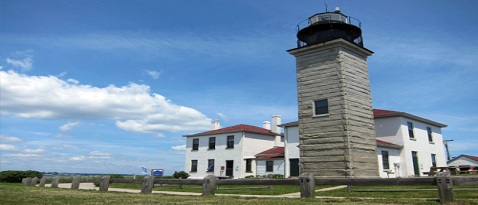Historic Jamestown
Jamestown, Rhode Island is located twenty-five miles south of Providence and a mile west of Newport, on Conanicut Island, in Narragansett Bay. It is both a summer destination and a year-round community with a population is about 6,000.
Conanicut Island is nine miles long by one mile wide. Its highest elevation is 135 feet. Sheep grazing and farming began in the sixteen-thirties. For well over two hundred years the island remained mostly agricultural.
Even today, there is a quiet rural character to much of the island and Jamestown’s commercial center has the feel of a traditional village. A few farms remain, older neighborhoods are intact and historic properties, including lighthouses, windmills and the remains of old military fortifications, offer connection to the past.
With its abundance of open space, lightly traveled roadways and pleasant views, the island is an excellent locale for walking and riding bicycles.
Humans arrived in the area about 10,000 to 12,000 years ago, at the end of the last ice age, when they settled near streams and rivers. Ongoing melting of glaciers caused the sea level to rise, covering low-lying areas and eventually filling Narragansett Bay. The rising sea forced humans to higher elevations, and submerged most traces of the earliest inhabitants. The oldest human artifacts found on Conanicut Island date from around 3000 BC.
If you like lighthouses, Jamestown is a great place to visit. At least eight lighthouses can be seen from various parts of Conanicut Island.
Beavertail Light an active lighthouse on the southern tip of Conanicut Island, is an area landmark and popular nature park.The current structure dates from 1856, when a 1749 lighthouse was replaced. Visit the Beavertail Light Museum Association site for more information. Additional information about Beavertail can be found at The Rhode Island Lights web site, along with material on several other area lighthouses.
Point Judith Light, an active light dating from 1857, is located on the western mainland. It guards the entrance to West Passage.
Castle Hill Light, built in 1890, is an active light on the eastern shore of the East Passage, just south of Newport. It is adjacent to the Castle Hill Cove Marina.
Rose Island Light, built in 1870, is a privately maintained aid to navigation situated just off Newport Harbor, near the Newport bridge. The first floor of the structure is a museum. It is accessible via the Jamestown Ferry. The Rose Island Lighthouse Foundation restored the lighthouse between the mid-1980s and 1993, maintains it and sponsors a number of educational and environmental service programs.
The Newport Harbor Light on Goat Island is another active East Passage light. Built in 1842, it marks the Newport Harbor entrance. It is located adjacent to the Hyatt Regency Hotel.
Dutch Island Light, in West Passage, is on the southern tip of Dutch Island, between Conanicut Island and the western mainland. Built in 1857, the light was deactivated in 1947. After years of deterioration, the light was leased to the Dutch Island Lighthouse Society, which has resulted in its refurbishment. Beginning November 2007, it has been reactivated with a new solar-powered light.
Plum Beach Light, a sparkplug-type lighthouse built in 1857, is located north of Dutch Island, in West Passage, almost beneath the Jamestown-Verrazano Bridge, from which it can be seen clearly from the westbound side. In 1941, following construction of the original Jamestown Bridge, it was judged to be unnecessary for navigation, and was deactivated. The deteriorated lighthouse was acquired by a group, The Friends of Plum Beach Light, which restored the exterior and installed a low power, Coast Guard approved light in late 2003.
The decommissioned Conanicut (North Point) Light guarded the northern tip of the island from 1886 until 1932. The lighthouse is now a private residence.
